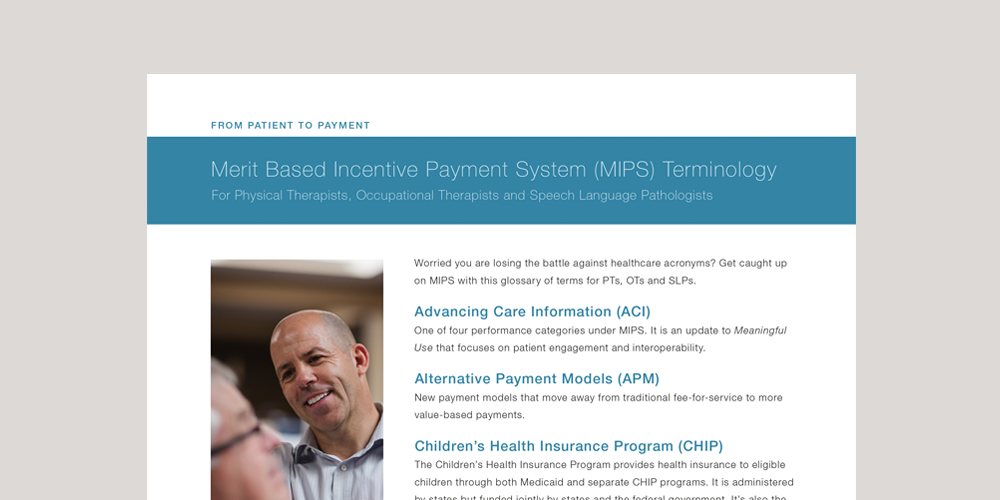With talk around MIPS getting louder and louder (see Clinicient’s MIPS 101 blog here), there are a lot of PTs wondering what the fuss is all about. After all, for 95 percent of physical therapists, reporting in the Merit-based Incentive Payment System will be optional in 2019. Treat fewer than 200 Medicare patients per year and bill anything less than $90,000 in allowed Medicare charges? You could chalk up the program as just another annoying acronym— one you don’t have to participate in if you don’t want to.
The question, of course, involves whether this is wise. Given that you can participate in MIPS as long as you meet one of its three key thresholds (care for at least 200 Medicare beneficiaries; have $90,000 in allowed charges for covered services; or provide at least 200 such services under the Medicare Physician Fee Schedule), what do you stand to lose by not opting in?
While everything is still technically subject to change until CMS publishes the final rule for the Quality Payment Program for 2019, we decided we’d answer that question based on the facts as they stand right now. For anyone considering ignoring MIPS, here are five of the biggest things you stand to lose out on.
- A possible 7 percent positive payment adjustment to your Medicare fee schedule
Based on their reporting in 2019, MIPS therapists will be eligible for bonus payment adjustments of up to 7 percent in 2021. The bonus payment will be scaled from 0-7 percent based on your actual performance scores and the performance thresholds set by Medicare in the final rule. This potential payout then increases to up to 9 percent in 2022 and beyond. However, it is important to understand there is also the potential to receive up to a -7 percent penalty payment adjustment if you perform poorly in MIPS.
Those who don’t participate in MIPS, on the other hand, will see a half-percent rate increase to their Medicare fee schedule in 2019, and then nothing further until at least 2025. And to pour more salt on the wound, the rate increase in 2026 is only slated to be a quarter of a percent. Not much of a raise, right?
- A possible additional 3-10 percent bonus if you’re among the MIPS top performers.
Also based on their 2019 results, therapists in the top quartile of all MIPS participants will be eligible for an additional 3 percent boost to their 2021 fee schedule, while those who rank in the 99th percentile will see that bonus climb to 10 percent. To be clear: These payments are on top of the base bonus adjustment described under #1, above. So, what happens if you’re among the best in 2021 and your base-bonus payout is 9 percent? Your total positive adjustment could reach 19 percent. There is a separate budget for this top performer budget and it will expire in the 2021 performance year. If you elect not to participate in MIPS in 2019 then you are missing the chance to capture the extra bonus reimbursement while it is still available.
- A chance to be in position as commercial payers embrace the MIPS model.
Recent surveys of private insurers show they’re also turning to value-based payment programs that reward providers for high-quality care. (One report predicts that fee-for-service payments will drop to 26 percent of reimbursement from commercial payers by 2021.) The implication for PTs who skip out on MIPS? You’re passing up a potentially lucrative opportunity to sharpen tools you’ll need across the entire reimbursement landscape.

Feeling lost in a fog of MIPS terminology? Download our free MIPS glossary to gain a better understanding of its common and not so common terms.
Download Glossary- An opportunity to prepare for the shift to APMs.
MIPS is designed as a hybrid program—a combination of fee-for-service with quality incentives. The long-term goal of CMS, however, is to move all providers to alternative payment models (APMs) where reimbursement depends entirely on care quality and cost-efficiency. PTs who decide to not participate in MIPS may miss their only chance to make that transition gradually.
- A chance to improve your practice and patient care and to have your performance scores published on the Medicare website.
Most PTs are in the profession for a reason: to make a real difference in patients’ lives. On top of everything else, participation in MIPS incentivizes providers to take a critical look at their practice and the assumptions they’ve made about how it should run. Think of MIPS as a push in the right direction—toward efficiency and quality, but also toward things like better patient engagement, and even toward administrative improvements like better data collection.
In addition, the Quality Payment Program requires Medicare to publish a provider’s quality performance scores on the Medicare.gov website after their second year of MIPS participation. What does this mean? Should you choose to sit out MIPS in 2019, your competition may have the advantage of pointing to their published performance scores while also highlighting your lack of participation. This could sway patients, referring physicians, and potential new hires from working with your clinic.
PTs who choose to let MIPS pass them by not only risk going out of business as fee-for-service reimbursement eventually dwindles and dies. They also miss out on a path to a better practice—a path that should ultimately lead to better patient care.
Disclaimer: The information provided herein is intended to be general in nature. It is not offered as legal or insurance related advice, and is not a complete description, or meant, or intended, to replace or be interpreted as specific, of Medicare requirements. Although every effort has been made to ensure the content herein is correct, we assume no responsibility for its accuracy. Contact Department of Health & Human Services (DHHS) Centers for Medicare and Medicaid (CMS) Services for more information.

Comments